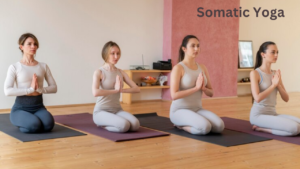Table of Contents
Discover the Benefits of Somatic Yoga
Introduction to Somatic Yoga
Somatic Yoga is a gentle, mindful approach to movement and body awareness. Unlike traditional yoga, which focuses on stretching and strengthening muscles, Somatic Yoga emphasizes slow, conscious movements that help you connect with your body on a deeper level. It’s all about listening to your body and moving in a way that feels good and natural.
What Is Somatic Yoga?
Somatic Yoga combines principles from somatics (a practice focused on body awareness) and yoga. The word “somatic” comes from the Greek word “soma,” meaning “body.” In this context, it refers to experiencing the body from within, rather than just looking at it from the outside.
In Somatic Yoga, you move slowly and mindfully, paying attention to how your body feels as you move. This practice can help release tension, improve posture, and increase flexibility. It’s not about pushing yourself to achieve difficult poses but rather about feeling comfortable and connected with your body.
Also Read- https://guidesbar.com/what-blogging-is-all-about/
How Does Somatic Yoga Work?
Somatic Yoga focuses on re-educating the brain and body through gentle movements. Over time, many of us develop habits and patterns of movement that can lead to stiffness, pain, and discomfort. These habits are often unconscious, meaning we might not even be aware of them.
In a Somatic Yoga practice, you’ll learn to move more mindfully and break free from these patterns. The slow, deliberate movements allow you to notice where you’re holding tension and release it. This process helps your brain “relearn” healthier ways to move, leading to greater ease and comfort in your body.
Key Benefits of Somatic Yoga
- Pain Relief: Many people find relief from chronic pain through Somatic Yoga. The gentle movements help release tension and improve alignment, reducing pain over time.
- Stress Reduction: Because Somatic Yoga emphasizes mindfulness and deep relaxation, it’s an excellent way to reduce stress. The practice encourages you to slow down and connect with your body, helping you feel more grounded and calm.
- Improved Flexibility and Mobility: Unlike traditional stretching, which can sometimes be uncomfortable or even painful, Somatic Yoga allows you to increase flexibility and mobility in a gentle, pain-free way.
- Better Posture: As you become more aware of your body and how you move, you’ll naturally start to improve your posture. This can lead to less strain on your muscles and joints.
- Enhanced Body Awareness: Somatic Yoga helps you tune into your body and become more aware of how you move and feel. This increased awareness can lead to a deeper sense of connection with yourself.
Also Read- https://guidesbar.com/why-is-wet-brush-better/
Simple Somatic Yoga Exercises to Try
Here are a few basic Somatic Yoga exercises that you can try at home:
- Pelvic Tilts: Lie on your back with your knees bent and feet flat on the floor. Gently tilt your pelvis forward and backward, noticing how your lower back moves in response. This exercise helps release tension in the lower back and improve mobility.
- Cat-Cow Stretch: On your hands and knees, gently arch your back (like a cat) and then round it (like a cow). Move slowly and mindfully, paying attention to how your spine feels as you move.
- Shoulder Rolls: Sit or stand comfortably. Slowly roll your shoulders forward, up, back, and down in a circular motion. This exercise helps release tension in the neck and shoulders.
Conclusion
Somatic Yoga is a powerful practice that can help you connect with your body in a deeper, more meaningful way. Whether you’re looking to relieve pain, reduce stress, or simply move more mindfully, Somatic Yoga offers a gentle, effective approach to improving your overall well-being. It’s not about perfecting poses but about finding ease and comfort in your body. Give it a try, and discover the benefits for yourself!
FAQs about Somatic Yoga
1. What is Somatic Yoga? Somatic Yoga is a gentle practice that combines principles of somatics and yoga. It focuses on mindful, slow movements that help increase body awareness, relieve tension, and improve overall well-being.
2. How is Somatic Yoga different from traditional yoga? Unlike traditional yoga, which often emphasizes stretching and strengthening, Somatic Yoga focuses on slow, conscious movements that help you connect with your body and release tension. The goal is not to achieve difficult poses but to move mindfully and comfortably.
3. Who can practice Somatic Yoga? Somatic Yoga is suitable for people of all ages and fitness levels. It’s especially beneficial for those dealing with chronic pain, stiffness, or stress, as it offers a gentle and accessible way to improve body awareness and movement.
4. Do I need any special equipment for Somatic Yoga? No special equipment is needed for Somatic Yoga. A comfortable space and a yoga mat are all you need to get started. Some people may also find props like cushions or blankets helpful for added support.
5. Can Somatic Yoga help with chronic pain? Yes, many people find relief from chronic pain through Somatic Yoga. The practice helps release tension, improve posture, and promote healthier movement patterns, all of which can contribute to pain reduction.
6. How often should I practice Somatic Yoga? You can practice Somatic Yoga as often as you like. Even a few minutes of mindful movement each day can make a difference. Consistency is key to experiencing the full benefits.
7. Is Somatic Yoga good for stress relief? Yes, Somatic Yoga is an excellent practice for stress relief. The focus on mindfulness and deep relaxation helps calm the mind and body, making it easier to manage stress and anxiety.
8. Can beginners do Somatic Yoga? Absolutely! Somatic Yoga is very beginner-friendly. The slow, gentle movements are easy to follow, and the practice can be adapted to suit any level of experience or flexibility.
9. How long are typical Somatic Yoga sessions? Somatic Yoga sessions can vary in length, from as short as 10-15 minutes to an hour or more. You can choose the duration that fits your schedule and needs.
10. Where can I learn Somatic Yoga? You can learn Somatic Yoga through online videos, classes, or workshops. Some yoga studios and wellness centers also offer classes specifically focused on Somatic Yoga.










